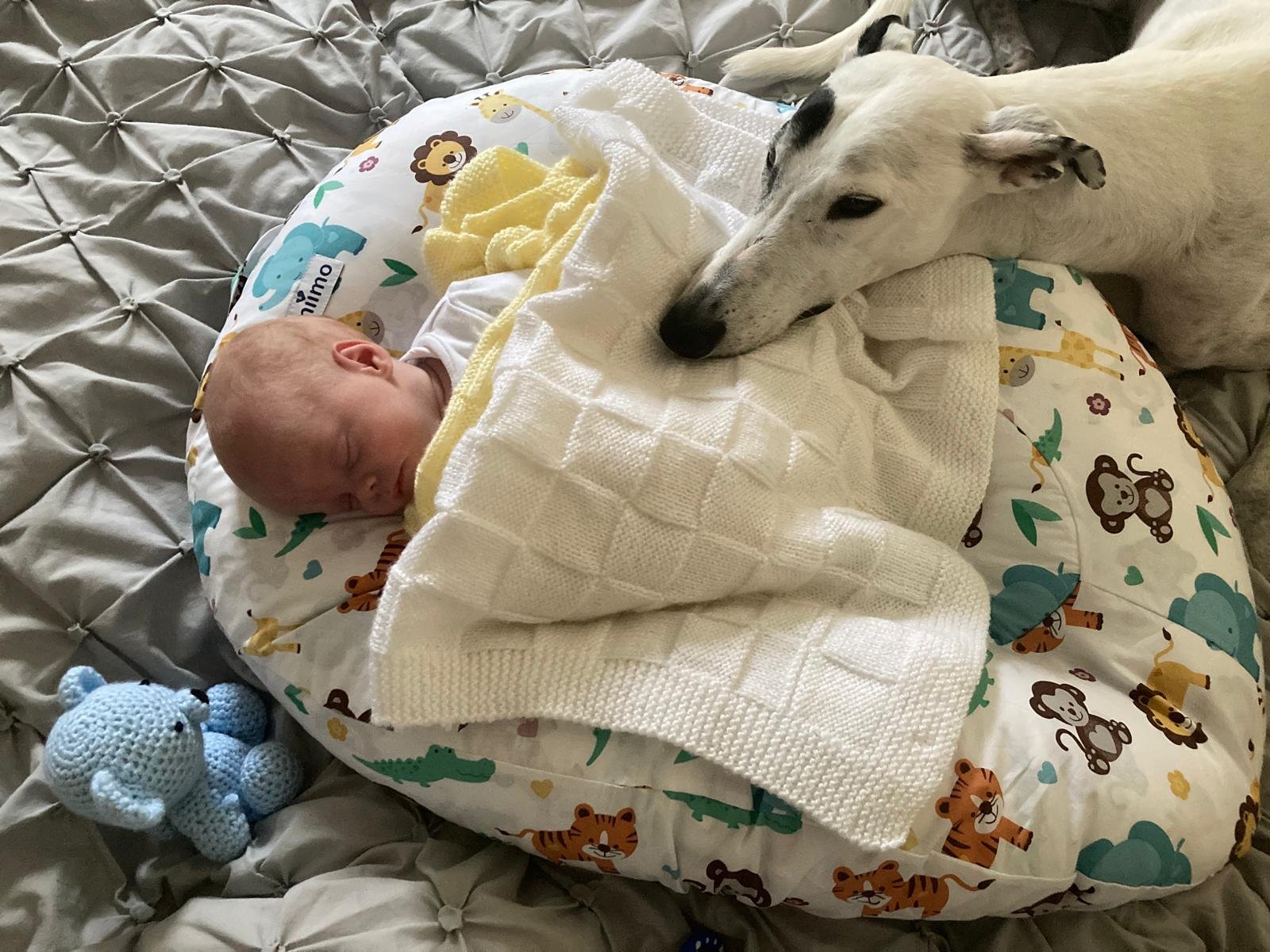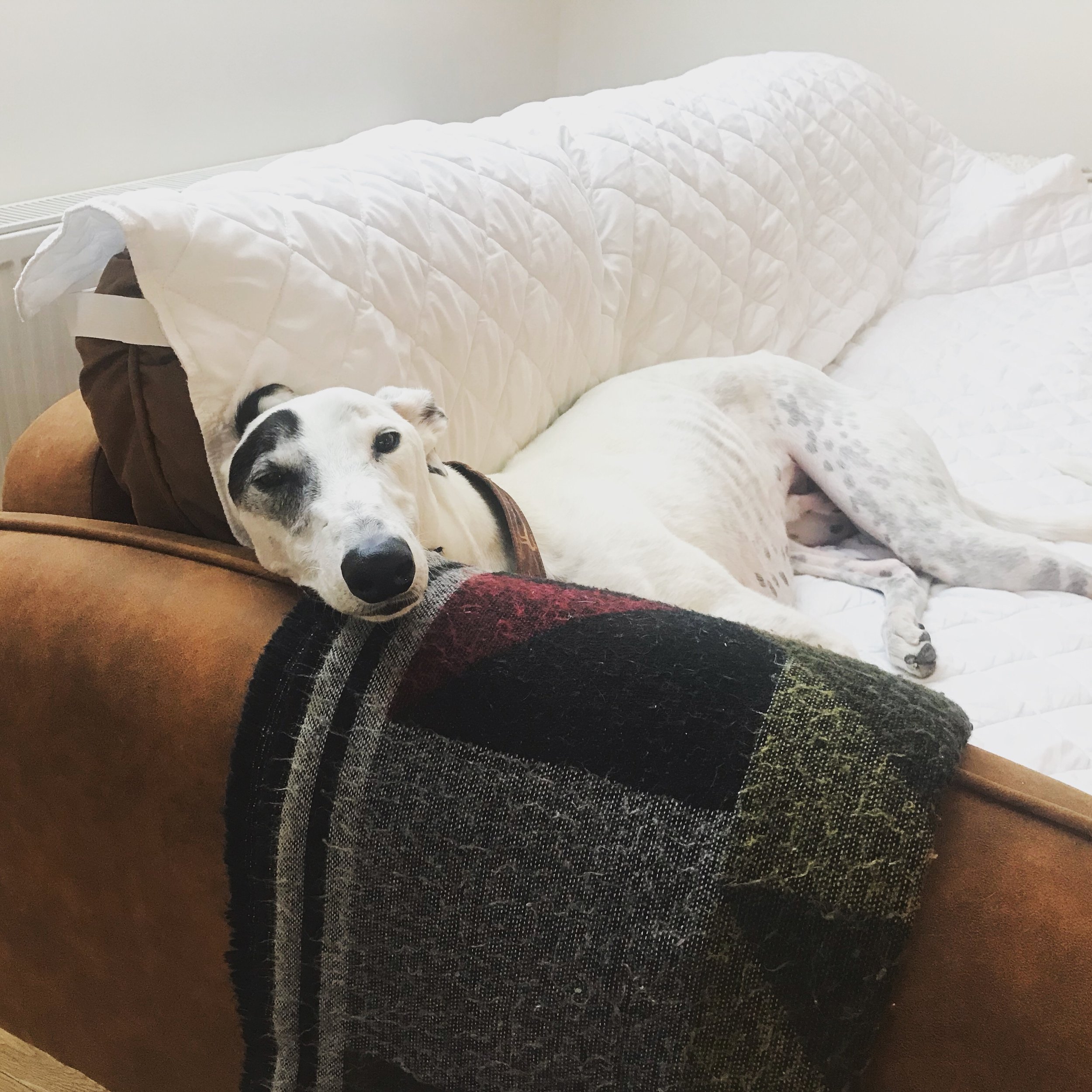Greyhounds 101: History, Personality, and Life as a Family Dog
Greyhounds as Pets: Graceful Companions with Gentle Souls
Greyhounds may be known for their lightning-fast sprinting on the racetrack, but beneath their aerodynamic build lies one of the oldest and most gentle dog breeds in the world. If you’re considering bringing one of these elegant creatures into your home, here’s what you need to know about life with a greyhound.
A Storied History: The Noble Hound
Greyhounds are not just swift (see how apt our greyhound’s name is!) —they’re ancient. These sighthounds have been depicted in art and literature for over 4,000 years, appearing in ancient Egyptian tombs, Greek pottery, and even the Bible. Revered for their beauty, speed, and loyalty, greyhounds were often associated with nobility and royalty. In fact, for centuries, only the aristocracy were permitted to own them. Today, they grace our homes not as status symbols, but as loving companions.
Historically, greyhounds were bred for hunting and coursing game like deer and hare. Their keen eyesight and explosive speed made them the ultimate hunting partners. Over time, as society shifted and dog racing gained popularity, their role changed—but their gentle temperament remained.
Personality: More Couch Potato Than You’d Think
Despite their athletic reputation, greyhounds are famously laid-back. Many adoptive owners are surprised to find that these dogs are professional loungers, happiest when snuggled on a soft bed. Ex-racing greyhounds are typically calm, gentle, and quick to adapt to home life. They may need time to learn the ropes of being a pet, such as navigating stairs or recognizing windows, but their affectionate, docile nature makes them quick learners.
Puppy greyhounds, on the other hand, are a different kettle of kibble. As with any puppy, they’re energetic, curious, and a little mischievous. Early socialization and consistent training are key to helping them grow into well-mannered adults.
Greyhounds are also known to be emotionally intuitive. They often mirror the energy in their environment—calm in quiet homes, more alert in active ones. They thrive on routine and gentle guidance, and while they enjoy company, they are often independent rather than clingy.
Built for Speed—Not Marathons
Greyhounds are the supermodels of the canine world: lean, long-legged, and built for bursts of speed. However, their exercise needs are surprisingly moderate. A couple of brisk 20-30 minute walks a day, plus occasional sprints in a secure area, are usually enough. After that? Nap city.
They’re often called “45-mile-per-hour couch potatoes,” and for good reason. They were bred to sprint short distances, not endure long runs or intense hikes. Over-exercising, especially in hot or cold weather, can be harmful.
Due to their thin coats and low body fat, greyhounds are sensitive to extreme temperatures and should be kept warm in winter and shaded in summer. Think sweaters and sunhats, not mud and rain.
If you have a secure garden or access to a dog park, let them stretch their legs in short bursts. But always supervise—if they spot a squirrel, their chase instincts may kick in at full throttle.
Trainability: Smart and Sensitive
Greyhounds are intelligent but can be independent thinkers. Training should be positive, patient, and consistent. They respond best to rewards like treats, praise, or affection. Here’s a quick guide for some common commands:
Sit: This can be tricky for some greyhounds due to their long limbs, but with repetition and rewards, many get it with time. Consider starting with a "down" command instead.
Stay: Use gradual distance and duration, always returning to reward.
Wait: Teach this at doors or before meals. Use a hand signal and reward calm behavior.
Leave it: Essential for controlling their prey drive—start with treats in hand and reward when they back off.
Always remember, patience is key. Greyhounds are sensitive souls and do not respond well to harsh correction.
Socialization is also vital, especially for ex-racers who may not have encountered the variety of sounds, surfaces, and settings of a typical home. Desensitization and calm introductions to new experiences are incredibly helpful.
Crate training can also be beneficial. Many greyhounds take naturally to crates, especially when they’re treated like a safe haven rather than a punishment.
Family Friendliness: Gentle with People, Watch the Prey Drive
Greyhounds are famously gentle and affectionate with children and adults alike. They often thrive in quiet homes but can adapt to family environments with supervision. However, their strong prey drive means smaller animals like cats, rabbits, or even squirrels may trigger their chase instinct. Some ex-racers can live with cats, but always conduct a proper introduction and seek guidance from a rescue organization.
Supervised play with children is encouraged, especially for younger kids who may not understand a dog’s need for space. Greyhounds rarely show aggression, but like any breed, they should never be treated like a toy.
If you have other dogs in the household, most greyhounds adapt well. They are usually sociable with other canines, particularly those their own size, and many ex-racers are already accustomed to kennel life with multiple dogs.
Size, Food, and Attention Needs
Greyhounds typically weigh between 60-70 pounds (27-32 kg) and stand about 25-30 inches tall at the shoulder. Despite their size, they are surprisingly graceful indoors and rarely clumsy. They eat less than you'd expect—usually around 2-4 cups of high-quality kibble a day depending on age, activity, and metabolism.
Feeding them smaller, more frequent meals can help prevent bloating or gastric torsion, a concern for deep-chested breeds. Always consult your vet for the best diet plan, and keep water available at all times.
They do crave companionship. While not prone to separation anxiety in the same way as some breeds, they prefer to be near their people. A greyhound left alone for long periods may become bored or stressed. If you work away from home often, consider adopting a pair—or arrange for midday companionship.
They also need comfortable places to rest—ideally multiple soft beds around the house. Because of their bony frames, they don't tolerate hard floors well. A nice big comfy bed will be needed if you want any time on your own sofa!
Other Considerations
Health: Greyhounds are generally healthy, with fewer inherited conditions than some other breeds. However, their low body fat affects anesthesia, so always choose a vet familiar with sighthounds. They're also prone to dental issues and should have regular teeth cleaning.
Grooming: A breeze! Their short coats shed minimally and only require occasional brushing and baths. A quick weekly brushing helps reduce shedding and keeps their coat smooth.
Nails: Their fast-growing nails can be an issue if not trimmed regularly. Long nails can impact their gait and cause discomfort.
Sleeping: They love soft bedding. Greyhounds aren’t big on hard floors. Many adoptive homes quickly discover that a greyhound will happily share your sofa—or even your bed.
Travel: Many greyhounds travel well in cars, but they should be secured safely with a seat belt harness or crate.
Muzzles: Some rescue organizations recommend or require greyhounds to wear muzzles in public, particularly early on. This isn’t because they’re aggressive—it’s often a precaution due to prey drive or unfamiliar situations.
If you would like to contact me about this blog or have a greyhound/dog related question, please get in contact with me by using the form below.





